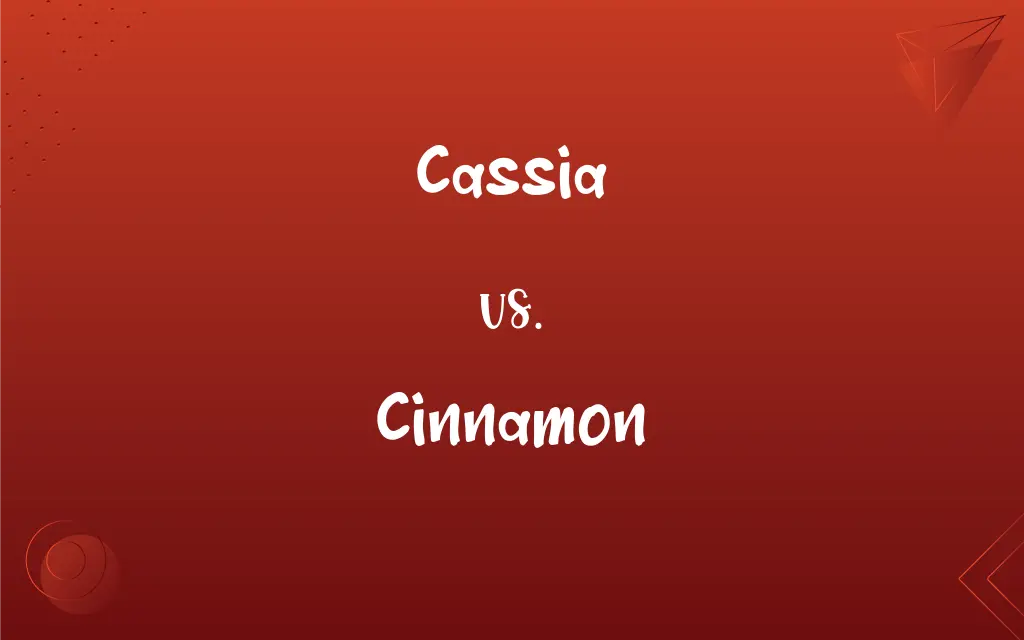Cassia vs. Cinnamon: What's the Difference?
Edited by Aimie Carlson || By Harlon Moss || Updated on October 17, 2023
Cassia is a type of cinnamon primarily from Southeast Asia, with a strong flavor; true cinnamon is milder, sourced mainly from Sri Lanka.

Key Differences
Cassia and cinnamon are both derived from the bark of trees in the Cinnamomum family. While they have similarities, they also possess distinct characteristics. Cassia is often recognized for its darker color and thicker bark, while cinnamon, specifically known as "true cinnamon" or "Ceylon cinnamon", has a tan color with a finer texture.
Both cassia and cinnamon have aromatic qualities and are used in various cuisines around the world. However, the flavor of cassia is more robust and slightly bitter compared to cinnamon, which offers a sweeter and more delicate aroma.
In terms of health benefits, both cassia and cinnamon have been lauded for their potential benefits. Yet, cassia contains a higher amount of coumarin, a natural substance that can be harmful in large quantities. On the other hand, cinnamon, especially Ceylon cinnamon, contains considerably less coumarin.
Geographically, cassia is primarily sourced from countries like China, Vietnam, and Indonesia. In contrast, cinnamon, especially the Ceylon variety, is predominantly found in Sri Lanka, although it's also grown in parts of India and Madagascar.
Lastly, when it comes to pricing, cassia is generally less expensive due to its abundant supply. Cinnamon, especially the Ceylon variety, tends to be pricier because of its esteemed quality and limited supply.
ADVERTISEMENT
Comparison Chart
Origin
Southeast Asia (China, Vietnam)
Sri Lanka, India, Madagascar
Bark Thickness
Thick and rough
Thin and papery
Flavor
Stronger, slightly bitter
Milder, sweeter
Coumarin Content
Higher
Lower
Price Point
Generally less expensive
Typically pricier
ADVERTISEMENT
Cassia and Cinnamon Definitions
Cassia
A close relative to true cinnamon but with a more assertive flavor.
I prefer using cassia over cinnamon in my recipes for a bolder taste.
Cinnamon
A popular ingredient in both savory and sweet dishes.
The curry was enhanced by a touch of cinnamon.
Cassia
A genus of flowering plants in the legume family.
The yellow blooms of the cassia tree brightened up the garden.
Cinnamon
A tan-colored bark with a sweet and delicate flavor.
True cinnamon has a more refined taste than its counterparts.
Cassia
A type of bark used as a spice, primarily from Southeast Asia.
The cassia in this dish gives it a rich and aromatic flavor.
Cinnamon
Often referred to as "Ceylon cinnamon" to distinguish from other types.
Make sure you buy Ceylon cinnamon for this recipe.
Cassia
A commonly used spice in traditional Chinese medicine.
The doctor prescribed cassia for its warming properties.
Cinnamon
A spice derived from the inner bark of Cinnamomum trees.
The aroma of cinnamon filled the kitchen as she baked the pie.
Cassia
A spice often found in commercial ground cinnamon products.
This cinnamon blend contains a mix of cassia and Ceylon varieties.
Cinnamon
A spice known for potential health benefits, including anti-inflammatory properties.
I take a cinnamon supplement daily for its health-promoting qualities.
Cassia
Any of various chiefly tropical or subtropical trees, shrubs, or herbs of the genus Cassia in the pea family, having pinnately compound leaves, usually yellow flowers, and long, flat or cylindrical pods.
Cinnamon
The dried aromatic inner bark of certain tropical Asian trees of the genus Cinnamomum, especially C. verum and cassia (C. aromaticum), often ground and used as a spice.
Cinnamon
A tree yielding this bark.
FAQs
Is there a difference between cassia and cinnamon?
Yes, while both are from the Cinnamomum family, cassia has a bolder flavor and is usually thicker, while cinnamon is milder and thinner.
What is cassia?
Cassia is a type of cinnamon primarily from Southeast Asia, known for its strong flavor.
Is cassia harmful to consume?
While cassia is safe in moderate amounts, it has higher coumarin content, which can be harmful in large quantities.
Where does cassia primarily originate from?
Cassia mainly comes from Southeast Asia, including countries like China and Vietnam.
What is true cinnamon?
True cinnamon, also called Ceylon cinnamon, is a variety sourced mainly from Sri Lanka with a milder flavor.
Are cassia and cinnamon used interchangeably in cooking?
They can be, but cassia's flavor is more robust, while cinnamon offers a sweeter profile.
How can I distinguish between cassia and cinnamon?
Cassia is usually darker with thicker bark, while cinnamon is tan and has a papery texture.
Is Ceylon cinnamon the same as regular cinnamon?
Ceylon cinnamon is often referred to as "true cinnamon," distinguishing it from other types like cassia.
Do both cassia and cinnamon have health benefits?
Yes, both are known for potential health benefits, though they vary in coumarin content.
Can I replace cinnamon with cassia in recipes?
You can, but be mindful of the stronger flavor profile of cassia.
What dishes commonly feature cassia?
Many Asian dishes, especially those from China, often incorporate cassia.
Can I use cassia and cinnamon in beverages?
Absolutely! Both are popular in drinks like teas, coffees, and mulled wines.
Which type of cinnamon is best for baking?
While subjective, many prefer the milder taste of true cinnamon in baked goods.
Why is cassia more common in supermarkets?
Cassia is more abundant and generally less expensive than true cinnamon.
Can consuming too much cassia be harmful?
Due to its higher coumarin content, excessive consumption of cassia might pose health risks.
Do cassia and cinnamon have the same health benefits?
While they share some benefits, their varying coumarin content means they should be consumed differently for health reasons.
Is cassia present in most store-bought cinnamon powders?
Yes, many commercial cinnamon products are actually a blend, with cassia being predominant.
Are cassia and cinnamon used in traditional medicines?
Yes, both have been used in traditional remedies, with cassia being popular in Chinese medicine.
Which is more expensive, cassia or cinnamon?
Cinnamon, especially Ceylon cinnamon, is generally pricier than cassia.
How do I store cassia and cinnamon?
Both should be stored in a cool, dry place, preferably in airtight containers.
About Author
Written by
Harlon MossHarlon is a seasoned quality moderator and accomplished content writer for Difference Wiki. An alumnus of the prestigious University of California, he earned his degree in Computer Science. Leveraging his academic background, Harlon brings a meticulous and informed perspective to his work, ensuring content accuracy and excellence.
Edited by
Aimie CarlsonAimie Carlson, holding a master's degree in English literature, is a fervent English language enthusiast. She lends her writing talents to Difference Wiki, a prominent website that specializes in comparisons, offering readers insightful analyses that both captivate and inform.









































































